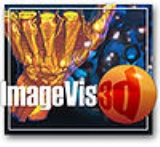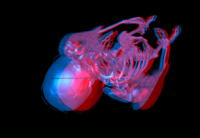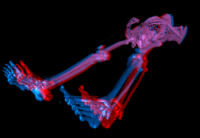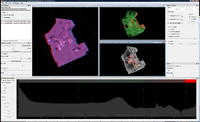
ImageVis3D
Encyclopedia
ImageVis3D is a lightweight, open source
, volume rendering
application for the interactive visualization
of very large volumetric data sets. It utilizes both the slice based as well as the GPU ray casting
approach to visualize the volume data. The source code
is currently maintained in a publicly accessible Subversion repository by the Scientific Computing and Imaging Institute
at the University of Utah
.
Visualization and Analytics Center for Enabling Technologies at the SCI Institute. After an initial development phase of about one year the project was released under the MIT license and since then multiple institutions from America, Europe and Asia are contributing to the software. Recently the first version of ImageVis3D mobile has been released, allowing for the mobile visualization of volumetric scalar data.

and VisTrails
Open source
The term open source describes practices in production and development that promote access to the end product's source materials. Some consider open source a philosophy, others consider it a pragmatic methodology...
, volume rendering
Volume rendering
In scientific visualization and computer graphics, volume rendering is a set of techniques used to display a 2D projection of a 3D discretely sampled data set.A typical 3D data set is a group of 2D slice images acquired by aCT, MRI, or MicroCT scanner....
application for the interactive visualization
Interactive visualization
Interactive visualization is a branch of graphic visualization in computer science that involves studying how humans interact with computers to create graphic illustrations of information and how this process can be made more efficient....
of very large volumetric data sets. It utilizes both the slice based as well as the GPU ray casting
Ray casting
Ray casting is the use of ray-surface intersection tests to solve a variety of problems in computer graphics. It enables spatial selections of objects in ascene by providing users a virtual beam as a visual cue extending...
approach to visualize the volume data. The source code
Source code
In computer science, source code is text written using the format and syntax of the programming language that it is being written in. Such a language is specially designed to facilitate the work of computer programmers, who specify the actions to be performed by a computer mostly by writing source...
is currently maintained in a publicly accessible Subversion repository by the Scientific Computing and Imaging Institute
Scientific Computing and Imaging Institute
The Scientific Computing and Imaging Institute is a permanent research institute at the University of Utah. It is a leader in engineering and research in the areas of scientific computing, visualization, and imaging...
at the University of Utah
University of Utah
The University of Utah, also known as the U or the U of U, is a public, coeducational research university in Salt Lake City, Utah, United States. The university was established in 1850 as the University of Deseret by the General Assembly of the provisional State of Deseret, making it Utah's oldest...
.
History
ImageVis3D's development was initiated in 2007 by the NIH/NCRR Center for Integrative Biomedical Computing and additionally supported by the DOEUnited States Department of Energy
The United States Department of Energy is a Cabinet-level department of the United States government concerned with the United States' policies regarding energy and safety in handling nuclear material...
Visualization and Analytics Center for Enabling Technologies at the SCI Institute. After an initial development phase of about one year the project was released under the MIT license and since then multiple institutions from America, Europe and Asia are contributing to the software. Recently the first version of ImageVis3D mobile has been released, allowing for the mobile visualization of volumetric scalar data.
Features
- has a rich feature set for volume rendering Cartesian scalar and color data
- supports 1D and 2D transfer functions as well as isosurface extraction and the ClearView rendering technique
- supports stereo rendering
- takes full advantage of the features of the newest generation of graphics cards but still works well on older hardware
- supports the most common industry and research file formats including DICOM stacks
- works entirely out of core, making it possible to interactively visualize hundreds of gigabytes of data on commodity hardware
- connects to ImageVis3D MobileImageVis3D MobileImageVis3D Mobile is a lightweight, open source, volume rendering application for interactive visualization on the iPhone and iPod Touch. It can display the built in visible human datasets as well as any dataset shared by the ImageVis3D application....
, an iPhoneIPhoneThe iPhone is a line of Internet and multimedia-enabled smartphones marketed by Apple Inc. The first iPhone was unveiled by Steve Jobs, then CEO of Apple, on January 9, 2007, and released on June 29, 2007...
/iPod touchIPod touchThe iPod Touch is a portable media player, personal digital assistant, handheld game console, and Wi-Fi mobile device designed and marketed by Apple Inc. The iPod Touch adds the multi-touch graphical user interface to the iPod line...
application, to allow for interactive volume rendering anywhere - is divided into multiple modules (e.g. UI, IO, rendering) which can all be used separately. Examples of such separate use are the integration of parts ImageVis3D into other open source and commercial products (see list below)
- is released under the MIT license
 |
 |
 |
 |

ImageVis3D in other applications
ImageVis3D or more precisely its volume rendering core has been incorporated into other applications such as VisItVisIt
VisIt is an open source interactive parallel visualization and graphical analysis tool for viewing scientific data. It can be used to visualize scalar and vector fields defined on 2D and 3D structured and unstructured meshes...
and VisTrails
VisTrails
VisTrails is a scientific workflow management system developed at the Scientific Computing and Imaging Institute at the University of Utah that provides support for data exploration and visualization. It is written in Python and employs Qt via PyQt bindings. The system is open source, released...

